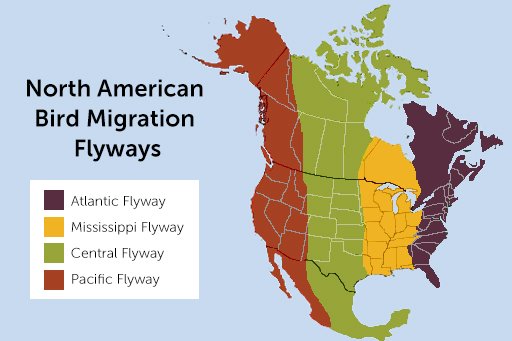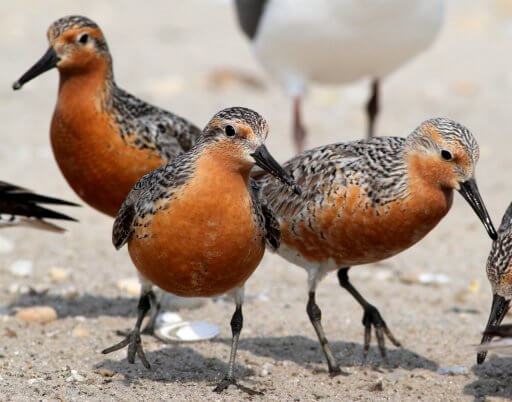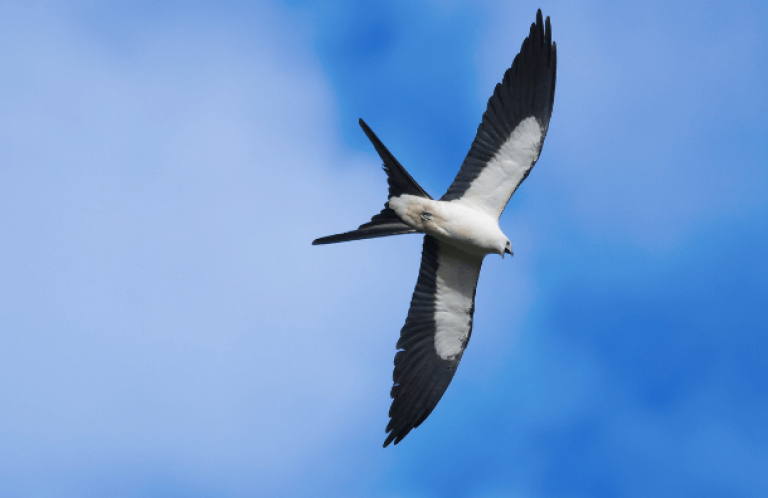Migration Marvels Millennia in the Making

Bird migration is a marvel that has captivated the human imagination for millennia. Some of the earliest cave art tells the story of the comings and goings of birds through the seasons. Waves of migratory herons, ibises, and quail are depicted as symbols of renewal in ancient Egyptian art. Birds took on deep meaning in folklore, myth, and religion across cultures. Among many Indigenous peoples, the arrival of waterfowl on the heels of the bitter cold months represents the first signs that the scarcity of winter is ending. In ancient Greece, the arrival of Barn Swallows was a sign for farmers to begin planting.
For as long as humans have seen in migrating birds the signs, symbols, and seasons that mark our lives, we have also longed to explain the “how” — and the “why” — of migration. It has taken us a while to get it right.
The annual disappearance and sudden return of the Barnacle Goose confounded Europeans for centuries. Some posited that the geese took to the sea and transformed into shells. After clinging to driftwood for months, they would wash ashore and emerge as fully formed geese. Questions about the nature of the Barnacle Goose's comings and goings raged on. Did this mean they were fish? Or birds? Finally, in 1215 CE, Pope Innocent III set matters straight: the Barnacle Goose was enough like a duck that it ought not to be eaten during Lent.
It would be several centuries before the real answer became known: Barnacle Geese weren't shape-shifting into tiny shells and clinging to wood at sea, nor were they growing on trees like fruit, as would later be suggested. They were simply migrating to Greenland to breed.
Centuries of record keeping, the development of formal research methods, and the ever-advancing precision of tracking technology are unraveling some of the mysteries surrounding birds' movements. While so much remains unknown, what we do understand of bird migration is enough to inspire the same kind of curiosity and awe that the Barnacle Goose did hundreds of years ago!
Birds are Masters of Night-time Navigation
While humans are ill-equipped for night-time navigation, many migratory birds are designed for it, with internal “compasses” that use their surroundings, the Earth's magnetic field, and the positions of stars to chart their courses.
Birds instinctively orient themselves to the celestial bodies overhead. Captive Indigo Buntings placed in a planetarium shifted course to maintain a northward position as the stars in the “sky” above them moved. Similarly, birds that migrate at night may take directional cues from the Sun's position as it sets. Earth's magnetic field also guides birds. Migratory birds have specialized magnetized cells, some of which are contained in their retinas, that function under dim blue light conditions like that of the night sky. Similar to the GPS unit in a car or phone, the magnetic field provides both a position and enables the bird to distinguish direction.

Most birds migrate along one of four major flyways, avian “superhighways” that have been used by birds for thousands of years. Every trip along a flyway enables an individual bird to further hone and refine its path north or south. While the routes may be familiar, the obstacles birds encounter along the way are not. One such unexpected obstacle is artificial lighting, which can disrupt birds' navigational capabilities.
Whether it's bright, concentrated light in a city or diffuse light from a sprawling suburb, artificial light can impair birds' navigational skills. Bright lights can make the “map” of the stars harder for birds to read and generally overwhelm the senses. Even low levels of artificial light produce red and yellow wavelengths that can interrupt the magnetic sensory cells in a bird's retina. The most experienced night-time traveler will struggle to stay the course when suddenly flooded with disorienting daylight.
Birds can circle lights to the point of exhaustion or land in unfavorable habitat and struggle to find food to refuel. But the greatest threat stemming from artificial lights happens when birds find themselves in a maze of reflective surfaces with no ability to distinguish reflections from the actual landscape. Up to one billion birds die from window collisions annually in the United States alone. Some species are more vulnerable than others, but window collisions are a threat to every bird, migratory or not.
Help flip the switch on artificial light. Use the minimum amount of lighting necessary for safety, turn off unnecessary lights at night, and support policy solutions that will have a wider positive impact on migratory birds. Complement your lights-out strategy by treating your windows to prevent window collisions day or night.
Birds Are Built for Endurance
A majority of the world's Blackpoll Warblers breed in the boreal forest in Canada, but their nonbreeding grounds are as far away as Brazil in tropical forests. Tiny geolocators affixed to the backs of birds have let scientists in on a migration secret: many Blackpoll Warblers, which weigh no more than an empty soda can (approximately 12 grams), are making nonstop, 72-hour flights over the Atlantic Ocean as they head south. That's a journey of some 1,800 miles — longer than a trip by car from Boston, Massachusetts to Miami, Florida!
To prepare for this arduous, nonstop journey, the Blackpoll Warbler bulks up, doubling its weight as it feasts on spiders, protein-rich insects like caterpillars, and fruits from native plants including honeysuckle and pokeberry. The process of putting on fat reserves before migration is called “hyperphagia,” and it is critical to ensuring the bird has the energy needed for the intense, long-distance flight.
All migratory birds need the extra bulk before they take flight, but they need to refuel at the stopover habitats they visit en route north or south, too. Habitat loss and a scarcity of high-quality habitat are the largest drivers of declines in bird populations. The Blackpoll Warbler has lost as much as 88 percent of its population since the 1940s, and the species is now considered Near Threatened by the International Union for Conservation of Nature (IUCN).
Start thinking of the spaces around you as valuable bird habitat! Learn the basics of bird-friendly gardening and begin landscaping with native plants to make your yard an inviting rest stop for migrating birds. Not only do native plants offer shelter and food on their own, but these plants also host the kinds of nutrient-packed insects that birds need ahead of their long flights. Treating your yard like bird habitat also means making sure birds are safe: be sure to avoid using pesticides to keep birds' food sources abundant, keep cats indoors, and treat windows to avoid collisions.
Birds Know that Home Is Where the Hatching Is
The Purple Martin is a striking bird, with glossy blue-black feathers that give it a sleek look befitting their swift movements. As North America's largest swallow species, the Purple Martin is built for life on the wing. It feeds, drinks, and even bathes and drinks mid-flight, dropping low to skim the water's surface as they glide by.
Purple Martins also have deep memories and return to the same location year after year to nest. While most Purple Martins in the western half of the U.S. nest in old woodpecker cavities, birds in the east tend to nest in human-provided housing. Indigenous communities would hang dried gourds for martins to use as nests, a practice that became widespread and persists today. Many families have been caring for “their” Purple Martins for decades and even centuries. The emotional pull of these gorgeous birds is strong, and people take pride in providing the nests that await the martins at the end of their long migration north.
Their fidelity to nesting sites necessarily makes Purple Martins superb navigators. From their nonbreeding grounds in the Amazon Basin, they travel northward to return to the same location every year. And Purple Martins aren't alone in their tendency to keep coming back. Many migratory species (including the most widely distributed swallow in the world, the Barn Swallow) are known to return to the same spot annually to nest.
Insecticides are some of the biggest contributors to the decline of the Purple Martin, Barn Swallow, and other aerial insectivores. These birds eat flying insects like beetles, wasps, cicadas, and dragonflies, which provide them with the nourishment needed to fuel their airborne lifestyle. Avoid using insecticides and other pesticides to maintain a healthy supply of food for martins, swallows, and other birds.
Birds Can Go the Distance
The long-distance marathons of many seabird species might make the Blackpoll Warbler's transoceanic journey look like a sprint! The elegant Arctic Tern nests around the Arctic Ocean before flying to the icy Antarctic during its nonbreeding season. In total, the Arctic Tern can log close to 50,000 miles in a single year — the equivalent of two trips around the globe. The Black-capped Petrel, part of a group of seabirds known as “gadfly petrels” for their speedy and frenetic flight, can fly 500 miles in the span of 24 hours.
Albatrosses spend their lives at sea, soaring over the open ocean and typically coming to land only during the breeding season. With wings spanning more than 6 feet, the Laysan Albatross can fly almost effortlessly, going for hundreds of miles in a single day when the winds are right. Wisdom, perhaps the most famous Laysan Albatross, also has the distinction of being the oldest known wild bird on record. In her more than 72 years of life, Wisdom is estimated to have flown an astounding 3 million miles and counting!
Seabirds are especially vulnerable to plastic pollution. Nesting seabirds face threats from introduced predators, including free-roaming cats, and nest disturbances. Reducing the single-use plastics in your life can help keep plastics from ending up in the oceans. Respecting nests, sharing the beach, and keeping cats indoors and dogs on leashes will make you a good neighbor to seabirds.
Above All, Birds are Resilient

One Red Knot reached at least the age of 19 (the average lifespan is five years) and had traveled farther than the distance of the Earth to the Moon. The Ruby-throated Hummingbird weighs less than a nickel but makes a straight flight across the Gulf of Mexico on wings that beat up to 80 times per second. The Swainson's Thrush has evolved the ability to snooze on the wing while keeping one-half of its brain alert to detect threats and avoid collisions. Some birds' bodies undergo drastic changes to prepare for migration, with their organs shrinking to make room for an enlarged heart and lungs. In a pinch, some species can convert muscle to energy once fat stores are depleted, enabling them to make it to a favorable place to land.
Migration is no small feat. It is an undertaking that is fraught with hazards and made all the more dangerous by human actions. Birds are naturally resilient, but resilience alone is not enough to withstand the challenges of navigating the human environment today.
At home or on vacation, in the suburbs, or in the office, there are many ways to help make the journey safer for migratory birds. Take steps to live a more bird-friendly life and use your voice to advocate for policies that protect the birds around you, whether they're year-round residents or simply passing through. Learn more about American Bird Conservancy's work to conserve birds from point A to point B and everywhere in between.



















































